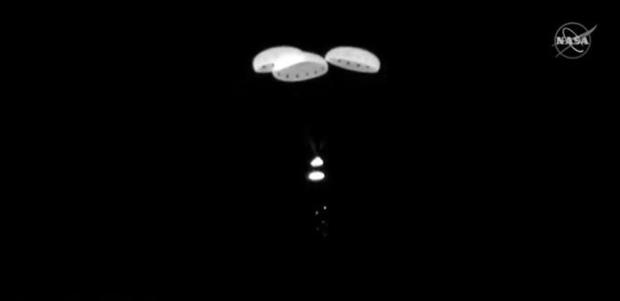Boeing’s unpiloted Starliner crew transport capsule plunged to an on-target touchdown in New Mexico Sunday, bringing an early end to a partially successful maiden flight marred by a timing glitch that derailed a planned rendezvous and docking with the International Space Station.
But the capsule’s flawless launch atop a United Launch Alliance Atlas 5 rocket Friday, the successful completion of many of the flight’s original test objectives and the smooth landing Sunday raise the prospect of a piloted test flight next year, although it’s not yet clear when.
Flying 155 miles above the southern Indian Ocean, four engines in the Starliner’s aft service module ignited and fired for 55 seconds starting at 7:23 a.m. EST, generating 6,000 pounds of thrust and changing the craft’s velocity by about 335 mph. That was enough to drop the far side of the orbit deep into the atmosphere over North America.
Trending News
After discarding the no-longer-needed service module, the capsule, traveling at nearly five miles per second, slammed back into the discernible atmosphere at an altitude of about 400,000 feet above the Pacific Ocean, enduring temperatures of some 3,000 degrees as atmospheric friction acted to rapidly slow the spacecraft to sub-sonic velocities.
Approaching the White Sands Missile Range landing site from the southwest, small drogue chutes deployed four-and-a-half minutes before touchdown, pulling out three large main parachutes at an altitude of about 8,000 feet that slowed the capsule to a much more sedate 19 mph or so.
The Starliner then jettisoned its heat shield, six large air bags inflated and the capsule touched down in pre-dawn darkness at 7:57 a.m., closing out a mission lasting two days, one hour and 21 minutes since launch Friday from the Cape Canaveral Air Force Station.
The unpiloted test flight originally was planned to last eight days, including a rendezvous and docking with the International Space Station. But a timing glitch in the spacecraft’s control system confused the flight computer, causing it to waste maneuvering fuel and preventing a rocket firing needed to put the vehicle on the proper trajectory.
The timing problem was quickly corrected, but mission managers opted to bring the spacecraft back to Earth on Sunday.
Despite the early end to the long-awaited mission, engineers carried out as many of the original test objectives as possible. The Starliner’s docking collar was extended and retracted, the capsule made radio contact with the space station, tested key navigation systems and executed a series of rocket firings to verify rendezvous procedures.
The unpiloted Starliner test flight was intended to clear the way for flights carrying astronauts to and from the space station staring in 2020. SpaceX also is building a commercial astronaut ferry ship for NASA and has already conducted a successful unpiloted flight to the space station.
The Starliner’s flight got off to a picture-perfect start Friday. About 15 minutes after release from the Atlas 5’s Centaur second stage, the capsule was expected to carry out an orbit insertion (OI) rocket firing to raise the low point of its orbit and set up the planned rendezvous with the space station.
But the OI burn never happened due to an internal mission-elapsed-time clock that was not tracking the actual time since takeoff. As a result, the Starliner’s flight computer thought the craft was not in the correct position and began firing multiple maneuvering jets in a futile bid to put the craft in an orientation that matched its mis-timed expectations.
Jim Chilton, Boeing vice president of space and launch systems, said Saturday the timing problem actually began before takeoff when the Starliner attempted to retrieve timing data from the Atlas 5.
“Our spacecraft needs to reach down into the Atlas 5 and figure out what time it is, where the Atlas 5 is in its mission profile, and then we set the clock based on that,” he said. “Somehow we reached in there and grabbed the wrong [number]. This doesn’t look like an Atlas problem. This looks like we reached in and grabbed the wrong coefficient.”
He said engineers did not yet know why the timer did not properly set itself.
“As a result of starting the clock at the wrong time, the spacecraft upon reaching space, she thought she was later in the mission, and, being autonomous, started to behave that way. And so it wasn’t in the orbit we expected without the burn and it wasn’t in the attitude expected and was, in fact, adjusting that attitude.”
Video from a camera on the Atlas 5’s second stage, released by ULA Saturday and posted by Boeing, showed the Starliner as it was released from the Centaur. Multiple maneuvering jets can be seen firing almost immediately, but the clip cuts off after a few seconds and it’s not clear if the burns were normal or a result of the timing problem.
In any case, Chilton said the timing issue and the flight computer’s confusion was compounded by trouble uplinking corrective commands to the spacecraft. Because the capsule was adjusting its orientation, its antennas were out of position to contact NASA’s communications satellite network.
The end result was a rapid-fire sequence of unplanned thruster firings that used up propellant needed for a space station rendezvous. The firings were so numerous, in fact, sensors overheated and one set of thrusters ran out of propellant.
“All of that appears to be just the sensors,” Chilton said. “And to prove that, over the last 24 hours the flight control team has been incrementally turning off the transducers, firing the thrusters and letting the guidance system say was there an effect on the spacecraft? And so far, they’re all working.”



